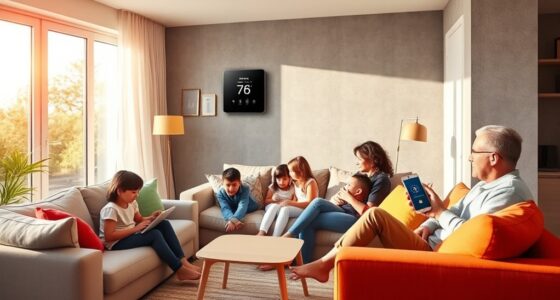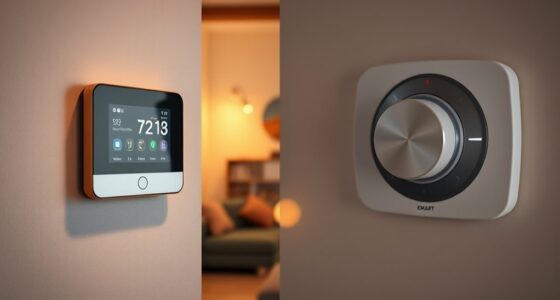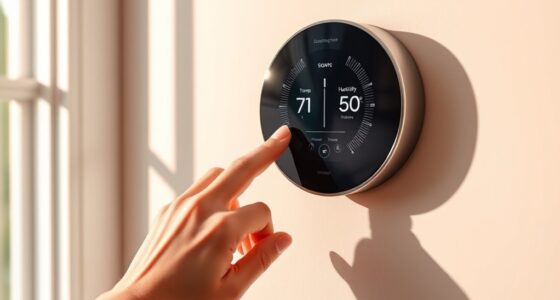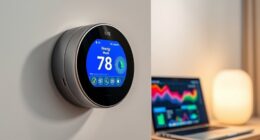To qualify for energy rebates with a smart thermostat, first check if your utility or local programs offer incentives. Make sure to purchase an approved model, install it correctly, and keep your receipts and proof of installation. Some programs require device registration or verification after setup. By following their specific steps and meeting eligibility rules, you can maximize your savings. Keep going to discover more tips on securing rebates and optimizing your energy use.
Key Takeaways
- Verify if local utility or government programs offer rebates for smart thermostats and confirm eligibility criteria.
- Purchase and install an approved smart thermostat, keeping receipts and proof of installation for documentation.
- Register your device if required and submit application forms along with supporting documents like receipts and model information.
- Ensure the smart thermostat meets program-specific efficiency standards to qualify for rebates.
- Take advantage of rebates to reduce upfront costs, and use energy-saving features to maximize long-term savings.
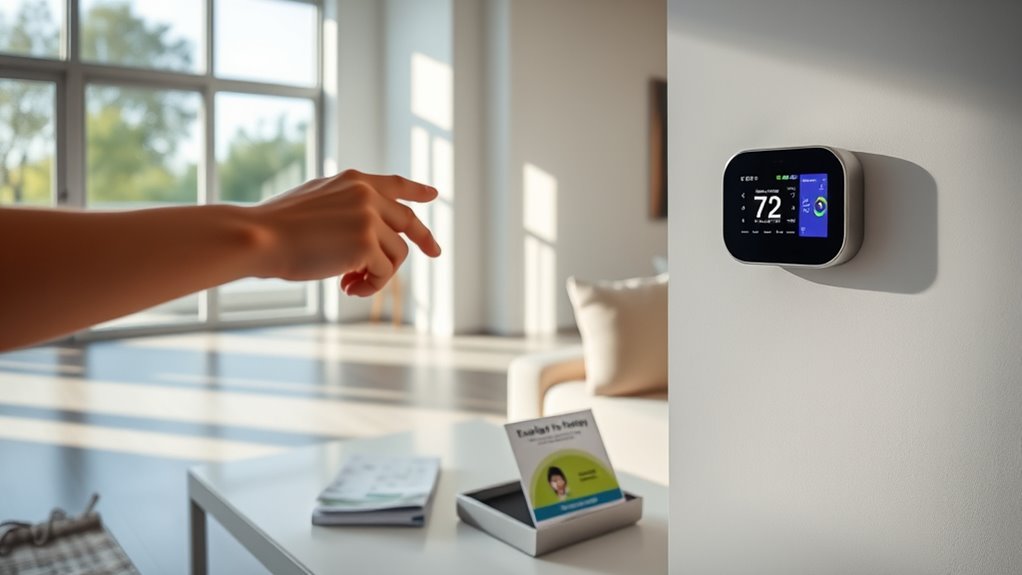
Are you looking for ways to cut energy costs and make your home more sustainable? One effective method is leveraging energy rebates, especially when you upgrade to a smart thermostat. These rebates can substantially reduce your initial investment, making it easier to adopt more efficient solutions. To qualify, you’ll want to explore various programs offered by local utilities, government agencies, or energy providers. Many of these programs aim to promote appliance efficiency and help homeowners save on energy bills. The key is understanding the specific requirements and ensuring your smart thermostat meets all criteria.
First, check if your utility company or local government offers rebates for installing a smart thermostat. These programs often have straightforward eligibility rules, such as being a residential customer or installing approved models. Once you confirm eligibility, you usually need to purchase and install a qualifying smart thermostat. Make sure to keep your receipts and installation proof, as you’ll need these when applying for the rebate. Some programs require you to register your device or submit a post-installation verification, so read the instructions carefully.
Check if your utility or local government provides rebates for qualifying smart thermostats and keep your receipts.
Applying for energy rebates is generally simple. Many programs provide online forms or require documentation via email or mail. When you apply, include evidence of appliance efficiency improvements, like a purchase receipt showing the model number and installation date. Some rebates are tiered, rewarding bigger energy savings, so consider opting for a more advanced model if it qualifies. This not only boosts your chances of approval but also enhances your home’s overall efficiency.
Using a smart thermostat can lead to considerable cost saving tips. For example, programming your device to lower the temperature during work hours or at night reduces unnecessary energy consumption. Many models allow you to set schedules, adjust remotely, and learn your habits over time, optimizing heating and cooling without you having to think about it. This smart control can cut your energy bills substantially while maintaining comfort. Additionally, the integration of smart home technology can further enhance your energy management strategies, making your home more efficient. Because smart thermostats optimize appliance efficiency, they often qualify for rebates, providing a financial incentive to upgrade.
In addition to rebates, these devices contribute to long-term savings. By reducing your energy consumption, you’ll notice lower utility bills month after month. Plus, many smart thermostats integrate with home automation systems, giving you more control and insights into your energy use. Moreover, understanding private placement memorandums can help investors evaluate the financial stability and potential risks associated with energy-related investments, ensuring smarter decision-making. It’s also important to consider regulatory compliance to ensure your device and installation meet all local standards. Overall, taking advantage of energy rebates for smart thermostats is a smart move—one that helps you save money, improve appliance efficiency, and support a greener home environment. Just make sure to research your options, follow application procedures, and enjoy the benefits of a more sustainable, cost-efficient home.
Frequently Asked Questions
How Long Does the Rebate Application Process Typically Take?
The application timeline for rebates varies, but generally, you can expect a processing duration of a few weeks. Once you submit your application, the review process begins, and they may request additional info. To guarantee a smooth process, double-check all your documents and receipts. If you’re patient and follow up if needed, you’ll likely receive your rebate within 4-6 weeks, depending on the program and their workload.
Are There Any Restrictions on the Brands of Smart Thermostats Eligible?
Ever wonder if your thermostat qualifies? Usually, brand restrictions are minimal, but it’s essential to check if your smart thermostat is compatible with your heating and cooling system. Some rebate programs specify approved brands or models, making it easier to qualify. Always review the specific eligibility criteria to guarantee your chosen thermostat fits the required compatibility standards, helping you access those energy savings without any hassle.
Can Renters Qualify for Energy Rebates With a Smart Thermostat?
You might wonder if renters can qualify for energy rebates with a smart thermostat. Renter restrictions and lease requirements vary by program, but many rebates are available to tenants if the property owner agrees. You should check specific eligibility rules, as some programs require the homeowner’s permission or proof of installation. Always confirm with your utility provider or rebate program to guarantee you meet all lease requirements before applying.
Is Professional Installation Required to Receive the Rebate?
Hold your horses, this isn’t the Wild West! When it comes to rebate eligibility, professional installation often isn’t a must, but it can be a wise move. Check the specific installation requirements for your rebate program, as some do require certified installation to qualify. Doing it yourself might save a buck, but make certain you meet all installation requirements to avoid disqualification. Always verify with your rebate provider for the most accurate info.
Are There Additional Incentives for Integrating Solar Energy Systems?
You might be eligible for additional incentives when you integrate solar energy systems. Many programs offer solar incentives that can reduce your upfront costs, and you could earn renewable credits for generating clean energy. Check with local or federal programs, as these incentives often vary by location. Installing solar panels may also qualify you for rebates and tax credits, making renewable energy more affordable and rewarding your efforts to go green.
Conclusion
Now that you know how to qualify for energy rebates with a smart thermostat, it’s time to take action! Don’t delay—dive into details, determine your eligibility, and make the most of these marvelous money-saving opportunities. By choosing to chase these chances, you not only cut costs but contribute to a cleaner, greener globe. Remember, smart decisions today secure savings tomorrow, so seize the smart thermostat rebate and start saving swiftly!



